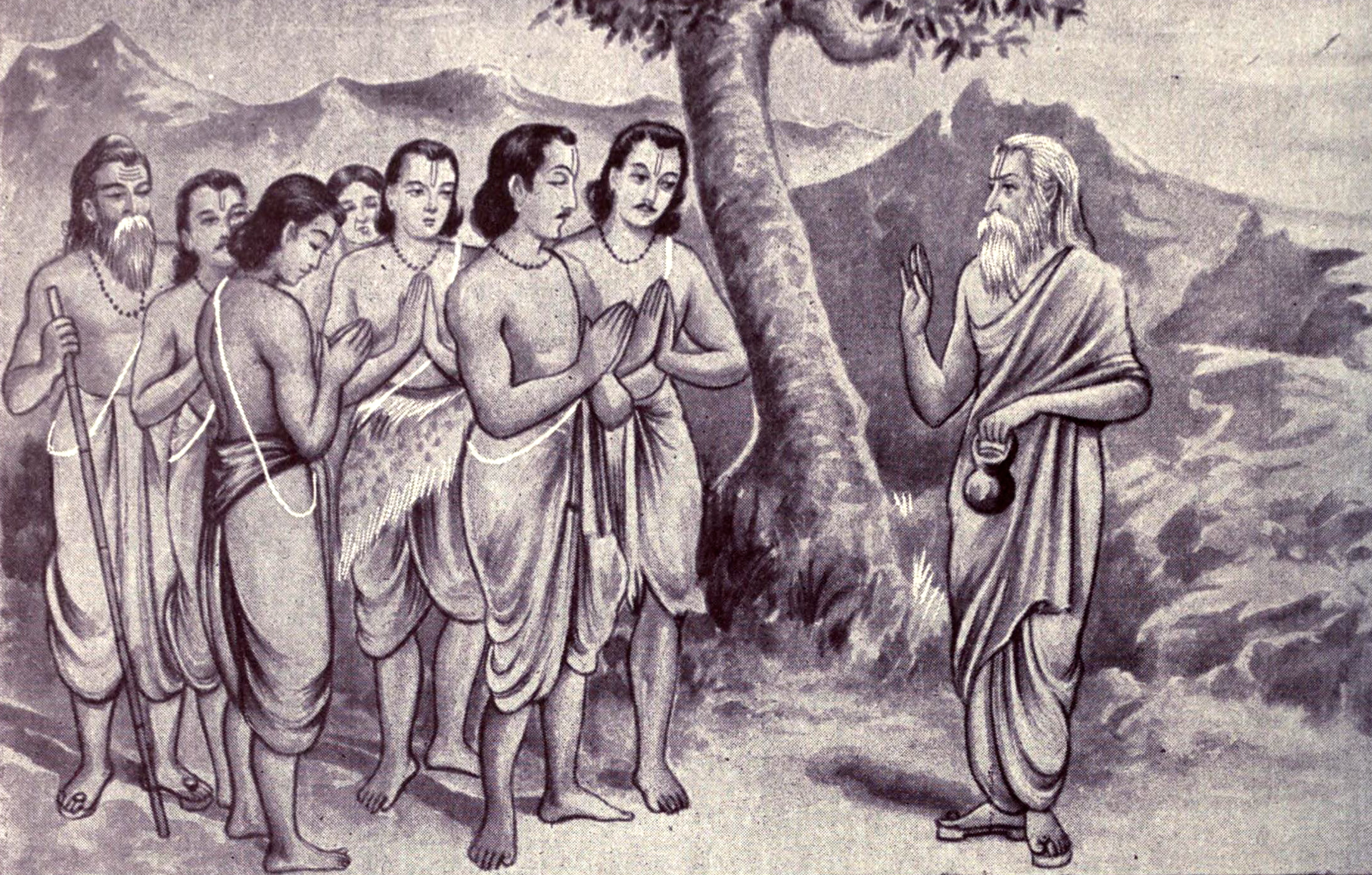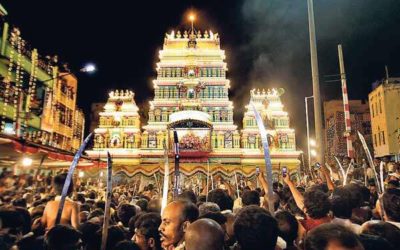First Ever Temple Dedicated to Veda Vyasa
It was on a cold, windy, February morning, on the outskirts of Haridwar, twenty eight years ago, that I stood witness to the kumbhabhishekam (consecration) of the first ever full fledged temple dedicated to Vyasa Muni (saint) the greatest and most prodigious author/ compiler of Hindu scriptures and epics the world has ever known. This recognition of the great saint’s centrality to the transmission of knowledge contained in the ancient Hindu scriptures, for future generations, was to say the least, long overdue.
Ignored by Mainstream Media
As a journalist of the Press Trust of India (PTI) New Delhi Bureau, I had been sent by my organization to report on this religious event in response to an invitation by the 700 year old Kashi Math Samsthan, which has revered the saint from its very inception and adopted him as their presiding deity.
I remember that the event was not given the prominence it deserved by the mainstream media and my memory cannot recall any newspaper carrying PTI’s report of the event which speaks volumes about the neglect of our rich heritage by modern society.
Knowledge about Vyasa Muni Limited in Indian Society
In retrospect, I am forced to admit that my knowledge of Vyasa at the time of the temple consecration was very limited. I knew him then only as the compiler of the Vedas and the author of the Mahabharatha. Little did I know that Vyasa was also an important protagonist of the epic; the splitter and simplifier of the vedas; writer and compiler of the 18 major Puranas; the Brahma Sutras, and the Upanishads to name just a few of his works.
Vyasa Single-handedly Penned the Vedas, Puranas and Epics
Vyasa, as I have come to know now, was also the author of the Guru Gita (Song of the Guru) a part of the larger Skanda Purana that highlights a conversation between Lord Shiva and his wife Goddess Parvati on the Guru and liberation. He also wrote the Yoga Bhashya, a commentary on the Yoga Sutras of Patanjali.
The Vishnu Purana lucidly expounds the pivotal role played by Vyasa in adapting the Vedas to the limited capacities of human beings to understand the great truths. It states “in every third world age (Dvapara), Vishnu, in the person of Vyasa, in order to promote the good of mankind, divides the Veda, which is properly but one, into many portions.”
Observing the limited perseverance, energy and application of mortals, he makes the Veda
fourfold, to adapt it to their capacities and the bodily form which he assumes, in order to effect this classification, it is known by the name Veda Vyasa.
Vyasa’s Motivation in Undertaking these Monumental Works
The question, however, remains as to what Vyasa’s motivation was in undertaking this monumental task? Swami Chinmayananda sheds some light in his tribute, “Vyasa The Versatile Genius”. According to him, Vyasa’s life was contemporaneous to events that put Hinduism in direct threat of annihilation. “The scriptures were fast fading away even among those who were supposed to be the custodians of sacred lore. The mantras of the Vedas were slowly being forgotten by the people.” In that general forgetfulness of the generation, the entire subjective science of the Vedas would have been lost, had it not been for the great revolutionary reformer, the poet-philosopher known as Vyasa, the Swami says.
As Vyasa moved around the country, realization dawned on him that there were various versions of the Vedas that was obliterating the original meaning. He therefore collected all the vedic passages and edited them into written volumes for the first time, from the oral tradition. He added the Upanishads (philosophical revelations) at the end of each of the Vedas. The philosophy of the Upanishads thus came to be known as the Vedanta, the end of the Veda.
Swami Chinmayananda’s Tribute to Vyasa
What Vyasa did for the common people through the splitting of the Vedas, he also did for the
pundits (experts) by penning the Brahma Sutras. He found that the essence of the Upanishadic literature was getting atrophied and slowly forgotten among the pundits, although the ritualistic portion was being followed faithfully. He therefore crystallized the philosophical thought of the Upanishads in the sutra form, into a text, the Brahma Sutras. It became the definitive text of Advaita Vedanta. Vyasa’s work thus became the substratum, the very foundation for the entire Hinduism that grew out of the Vedantic tradition, according to Chinmayananda.
According to Swami Chinmayananda, “Vyasa had become an institution representing the Hindu heritage and that no scriptural study or vedic chanting has ever begun without prostrations unto this greatest of seers.” He further says if we must attribute Hinduism to any single individual “there is none else to whom we can most appropriately attribute its present existence and past glories, except to Veda Vyasa.”
Vyasa’s Great Humanitarian Outpouring in the Bhagavad Gita
Vyasa’s concern about the path society was taking is tellingly brought forth in his final lament in the Mahabharata when he asks his son Suka to read with him the final four verses of the epic contained in book 18 of Svargarohanika Sarva Parva. I quote from its English translation by Kisari Mohan Ganguly.
“Thousands of mothers and fathers, and hundreds of sons and wives arise in the world and depart from it. Others will (arise and) similarly depart. There are thousands of occasions for joy and hundreds of occasions for fear. These affect only him that is ignorant but never him that is wise. With uplifted arms I am crying aloud but nobody hears me. From Righteousness is Wealth as also Pleasure. Why should not Righteousness, therefore, be courted? For the sake neither of pleasure, nor of fear, nor of cupidity should any one cast off Righteousness. Indeed, for the sake of even life one should not cast off Righteousness. Righteousness is eternal. Pleasure and Pain are not eternal. Jiva is eternal. The cause, however, of jivas being invested with a body, is not”.
Vyasa’s Birth and Lineage
Vyasa was born into a very distinguished lineage. The divine circumstances of his birth with
surreal elements are enough for the perceptive to realize that here, in this boy, there was greatness. His father was Sage Parashara while his mother was a fisher woman called Satyavathi. Legend has it that while being rowed across the river Yamuna by Satyavathi, Parashara fell in love with her and their amorous relationship led to the immediate birth of their lovechild.
Vyasa who grew into a boy immediately, started work on the Vedas. The significance of this relationship shows that the circumstances of birth is not important but the erudition and learning of the person is what matters in typifying that person’s caste.
Vyasa’s father Parashara is well known for his book on astrology, “Brihat Parashara Hora Shastra”, which is still the definitive book on Indian astrology. Parashara’s grandfather was the Sage Vasishta, one of the Sapta Rishis. Vashita was also the guru of Prince Rama. Vasishta’s father was Brahma himself.
Appearing for the first time as a compiler of the Bhagavad Gita, Vyasa was the grandfather to both the Kauravas and Pandavas. Their fathers, Dhritarashtra and Pandu respectively, and uncle Vidura, were Vyasa’s sons.
Vyasa is considered to be one of the seven Chiranjeevis (immortals) who are still in existence in the world.. The festival of Guru Purnima is dedicated to him and is also known as Vyasa Purnima for it is the day of his birthday and also the day he divided the Vedas.
[Kanaka Nagaraj Sabapathy is a former Delhi PTI Special Correspondent and also a Barrister & Solicitor]
- http://www.gsbkonkani.net/Maths/SHRI%20KASHI%20MATH%20SAMSTHAN.htm
- http://www.chinmayayuvakendra.org/index.php?option=com_content&view=article&id=275&s=959&p=506&f=960&Itemid=960
- http://www.sacredtexts.com/hin/m18/m18005.htm
- Vyasa%20%20Wikipedia,%20the%20free%20encyclopedia.htm



0 Comments